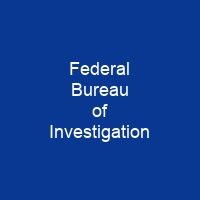The Federal Bureau of Investigation (FBI): A Brief Overview
Imagine a behemoth of law enforcement and intelligence operations, tasked with safeguarding America’s interests both domestically and internationally. That’s the Federal Bureau of Investigation (FBI). Established in 1908 as the Bureau of Investigation, it has since evolved into one of the most recognizable names in American law enforcement.
Origins and Evolution
The FBI’s journey began with the establishment of the National Bureau of Criminal Identification in 1896. This early precursor laid the groundwork for what would become a formidable agency. By 1908, it had transformed into the Bureau of Investigation under Attorney General Bonaparte’s leadership. The name change to Federal Bureau of Investigation (FBI) came in 1935, marking another significant milestone.
Key Figures and Milestones
J. Edgar Hoover served as director from 1924 until his death in 1972, overseeing a period marked by both groundbreaking achievements and controversial practices. His tenure saw the creation of the Scientific Crime Detection Laboratory (now known simply as the FBI Lab), which played a crucial role in forensic science advancements.
Current Structure and Operations
The FBI is headquartered at the J. Edgar Hoover Building in Washington, D.C., with 56 field offices and over 400 resident agencies across the United States. Its mission spans a wide array of federal crimes, from cybercrime to public corruption.
Organizational Structure
The FBI is organized into functional branches and the Office of the Director. Key divisions include Homeland Security Investigations (HSI), Victim Services Division, Operational Technology Division (OTD), Laboratory Division (LD), and Training Division (TD). Each plays a vital role in ensuring national security and law enforcement.
Technology and Innovation
The FBI has made significant strides in technology. The Trilogy project aimed to modernize its IT infrastructure but faced numerous challenges, including budget overruns and delays. Despite these setbacks, the agency continues to innovate through initiatives like the National Virtual Translation Center and plans for an FBI Innovation Center.
Controversies and Challenges
The FBI has not been without controversy. From handling of domestic surveillance during the Cold War to the use of entrapment tactics, the agency has faced criticism over its practices. Notable cases like Robert Hanssen’s espionage and the Ruby Ridge shootout have cast a shadow on its reputation.
Public Perception
The FBI’s portrayal in popular media often paints it as a hero, but reality is more complex. Civil liberties groups argue that the agency has disproportionately targeted left-leaning movements while underfunding right-wing surveillance. The balance between national security and individual rights remains a contentious issue.
Conclusion
The Federal Bureau of Investigation (FBI) stands as a pillar of American law enforcement, with a rich history and an ever-evolving mission. From its humble beginnings to its current status as a global intelligence powerhouse, the FBI continues to adapt to new challenges while navigating the complexities of modern society.

You want to know more about Federal Bureau of Investigation?
This page is based on the article Federal Bureau of Investigation published in Wikipedia (retrieved on March 7, 2025) and was automatically summarized using artificial intelligence.






